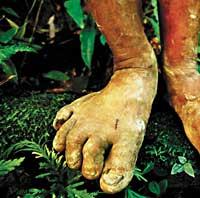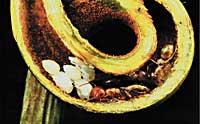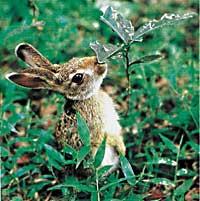On our wild side
2005/04/01 Arrate Larrañaga, Begoña Iturria: Elhuyar aldizkaria
The power of reproduction in living beings is undeniable. Animals that reproduce by sexual means usually have certain characteristics, systems, strategies and conflicts. On the other hand, in this field there are specific characteristics and behaviors that characterize the human beings of the rest of animals.
All this is worked in science in the fields of evolutionary ecology of behavior and optimization of life cycles, and in this article it is intended to explain it easily...
Willing to take a walk through our wild side?
[It is recommended to leave the route map. Each one can make the journey to its measure, spreading and linking the information that interests it most through the milestones… That you enjoy it!]
Route map

The multiple life strategies that can be found in nature have a double objective: to ensure the survival of the individual and optimize its reproduction.
Sense of reproduction
Why is reproductive instinct so powerful? [ Guidepost 1 ] As a metaphor, we could say that reproduction is a fiberglass throughout time, able to send to a future a series of information that includes our essence. Sexual reproduction can be both ] and asexual. The animals we reproduce sexually have common characteristics, systems, strategies and conflicts, as we will see.
How and with whom?
While the diversity of sexual reproduction systems in animals is enormous, we can distinguish four main types [ mojón 3 ]. What does it depend on species having a reproduction system or another? [ Mojón 4 ]
Intergenerational conflicts
Anyone knows that intergenerational conflicts are common. These conflicts occur when the interests of parents and descendants are incompatible. Descendants tend to demand more care and resources than those strictly necessary, and the father and mother, in some way, must defend themselves from descendants who have that tendency. Intergenerational conflicts not only occur in animals, but have also been observed in plants. [ Mojón 5 ]
Free altruism?

Behavior of working hymenoptera away from altruism.
The type of society of ants, bees and wasps (Basque society) was a type of altruism. In this type of society are the barren castes of the workers. Taking care of their sisters, their genetic information passes to the next generation in greater proportion than possessing descendants. [ Mojón 6 ]
In the forests of Borneo there is a symbiosis between the ant of the genus Colobopsis and the nephew plant. In the photo we see the work ants taking care of their sisters.
The one that impels us to adopt [Mojón 7]
Compensation of sex
Some living beings that reproduce asexually (by moaning or division) do not age, such as plants. On the other hand, some organisms are able to live infinitely in certain conditions thanks to their repair mechanisms (for example, each own reproductive cell comes from the cell line created thousands of years ago).
The natural selection bets on adaptations that lead to the proliferation of living beings with the maximum success, that is, for the reproductive efficiency. It can be thought that a longer life without old age would increase the effectiveness of reproduction. So how have the genes that lead to senescence (aging) and death prevailed?

Natural selection negatively affects mutations that can cut the lives of those who have not yet reproduced or are of childbearing age, etc., that is, will tend to eliminate them. But the later the gene is expressed that can reduce life or whatever, the less natural selection will influence it. And it is that by the time the gene is expressed this being has had the opportunity to reproduce like the others, so the selection has not affected him negatively.
You can't have it. The maintenance and tenure of a body of maximum quality implies a decrease in the growth of the organism and the juvenile fertility: the growth will be slower and, as the energy will be invested in the growth, the reproduction age will be later. Consequently, in this case, the effectiveness of average reproduction in youth will also be lower.
There are two hypotheses to explain the cause of aging. [ Mojón 8 ]
BIBLIOGRAPHY BIBLIOGRAPHY
- Agustí, J. • Tusquets Publishers. Barcelona, 2003. Boyd, R., and Silk, J. B. B. Nola evolved humans. Editorial Ariel. Barcelona, 2001. Elosegi, A. Sex, the driving force of evolution: reproductive strategies in the evolutionary game. Elhuyar Kultur Elkartea. Usurbil, 1995. Peláez del Hierro, F. and Veà Baró, J. Ethologia. - Editions Pyramid. Madrid, 1997.



